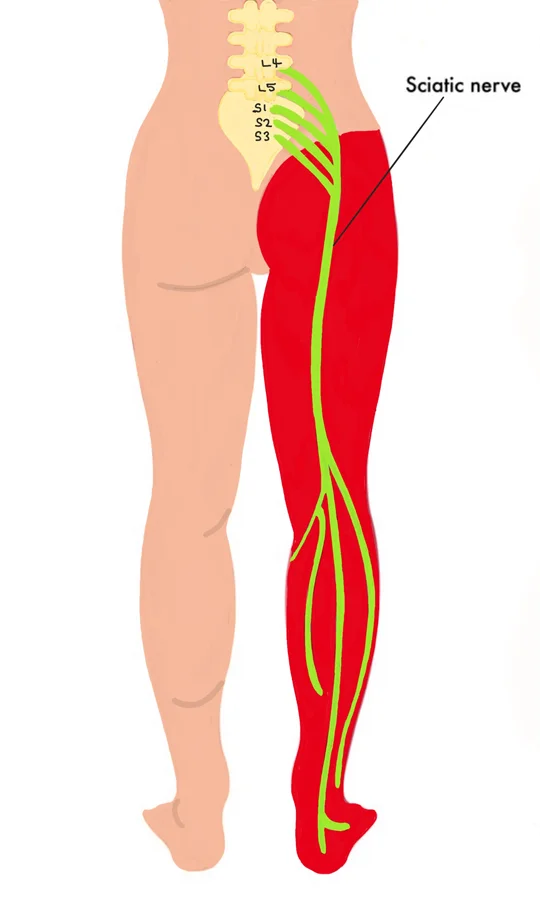
Sciatica is a condition often used to describe pain radiating along the sciatic nerve, which extends from your lower back through the hips and buttocks and down each leg. While the term is widely recognized, it’s worth noting that “sciatica” is not a precise medical term. In medical science, the correct terminology for this condition is “lumbar radiculopathy”, which refers to nerve irritation or compression in the lumbar or sacral regions of the spine. At Stavya, we aim to bridge the gap between medical knowledge and patient understanding, offering personalized care supported by advanced diagnostic tools like the Open Standing MRI.
What is Sciatica?
Sciatica, or lumbosacral radiculopathy, is not a disease itself but a symptom caused by compression or irritation of the sciatic nerve. This nerve controls muscles in the back of the knee and lower leg and provides sensation to the back of the thigh, lower leg, and foot. Addressing the root cause of nerve compression is essential for effective management.
Symptoms of Sciatica
Sciatica symptoms vary but commonly include:
- Radiating Pain: Pain that starts in the lower back and travels down the leg.
- Tingling or Numbness: Often experienced in the leg or foot.
- Weakness in the Leg or Foot: Difficulty in movement due to nerve irritation.
- Pain Worsened by Certain Postures: Activities like prolonged sitting or standing can aggravate discomfort.
At Stavya, we frequently diagnose cases using our Open Standing MRI, which provides clearer images by capturing the spine in natural, weight-bearing positions—offering a more accurate understanding of how nerve roots are affected.

What Causes Sciatica?
The underlying causes of sciatica, or lumbosacral radiculopathy, include:
- Herniated Discs: A protruding or ruptured disc pressing on the sciatic nerve.
- Spinal Stenosis: Narrowing of the spinal canal that compresses nerve roots.
- Piriformis Syndrome: Muscle spasms causing sciatic nerve irritation.
- Spondylolisthesis: A vertebra slipping forward and pinching the nerve.
- Trauma or Injury: Accidents that result in nerve compression or damage.
The advanced imaging capabilities of our Open Standing MRI at Stavya allow for a more dynamic assessment, helping identify issues that static imaging might miss.

Relief Tips for Sciatica
- Self-Care Strategies
- Cold and Heat Therapy: Use cold packs initially to reduce inflammation, then apply heat to relax muscles.
- Stretching and Exercises: Gentle stretching, such as yoga or specific back exercises, can relieve nerve pressure.
- Over-the-Counter Pain Relievers: Medications like ibuprofen may help manage temporary discomfort.
- Medical Interventions
- Physical Therapy: A structured program to strengthen the back and core muscles.
- Injections: Corticosteroids may provide temporary relief by reducing inflammation around the nerve.
- Minimally Invasive Surgery: Options like microdiscectomy can be considered in severe cases.
Our specialists at Stavya emphasize evidence-based approaches to pain management and recovery, ensuring treatment is tailored to each individual’s needs.
Preventing Sciatica
Lower your risk of developing sciatica with these lifestyle changes:
- Maintain Proper Posture: At work and home, avoid slouching or prolonged sitting.
- Use Correct Lifting Techniques: Always bend at the knees, not the waist, to lift heavy objects.
- Stay Physically Active: Regular exercise strengthens the back and core.
- Healthy Weight Maintenance: Reduces stress on the lower back.
By adopting these habits and seeking early intervention when symptoms arise, you can reduce the chances of recurrent sciatica.
Why Choose Stavya for Spine Care?
At Stavya, we combine expertise with technology to offer world-class spine care. Our Open Standing MRI ensures a precise diagnosis by imaging the spine in functional, weight-bearing postures—something traditional MRIs can’t achieve. This allows us to craft personalized treatment plans, empowering patients to regain mobility and live pain-free.
Final Thoughts
Although the term “sciatica” is commonly used, understanding that it refers to a broader medical condition, lumbosacral radiculopathy, can help patients make informed decisions about their health. From self-care remedies to advanced diagnostics and treatments, managing sciatica is possible with the right approach.
For expert care and a better understanding of your spine health, visit stavyaspine.com. Our team is here to support you at every step of your recovery.
Disclaimer: This blog is for informational purposes only and does not substitute professional medical advice. Always consult a healthcare provider for personalized care.
References:
- Valat, J.P., et al. “Sciatica.” Best Practice & Research Clinical Rheumatology, vol. 24, no. 2, 2010, pp. 241-252. PubMed
- Ropper, A.H., and Zafonte, R.D. “Sciatica.” The New England Journal of Medicine, vol. 372, no. 13, 2015, pp. 1240-1248. PubMed
- Pinto, R.Z., et al. “Drugs for relief of pain in patients with sciatica: systematic review and meta-analysis.” BMJ, vol. 344, 2012, e497. PubMed
- Fernandez, M., et al. “Advice to stay active or structured exercise in the management of sciatica: a systematic review and meta-analysis.” Spine, vol. 40, no. 18, 2015, pp. 1457-1466. PubMed
- Lewis, R.A., et al. “Comparative clinical effectiveness of management strategies for sciatica: systematic review and network meta-analyses.” Spine Journal, vol. 15, no. 6, 2015, pp. 1461-1477. PubMed



